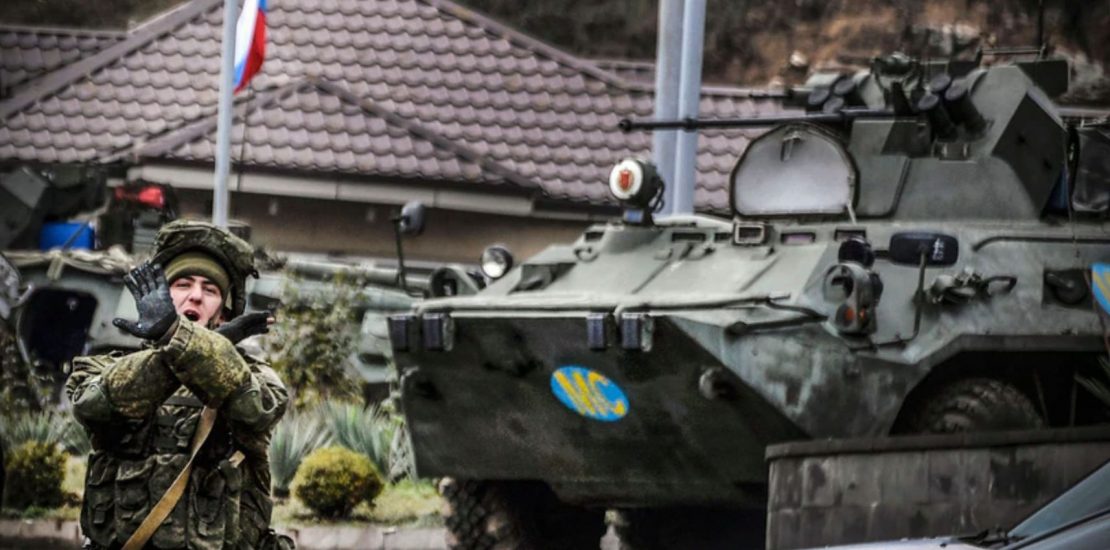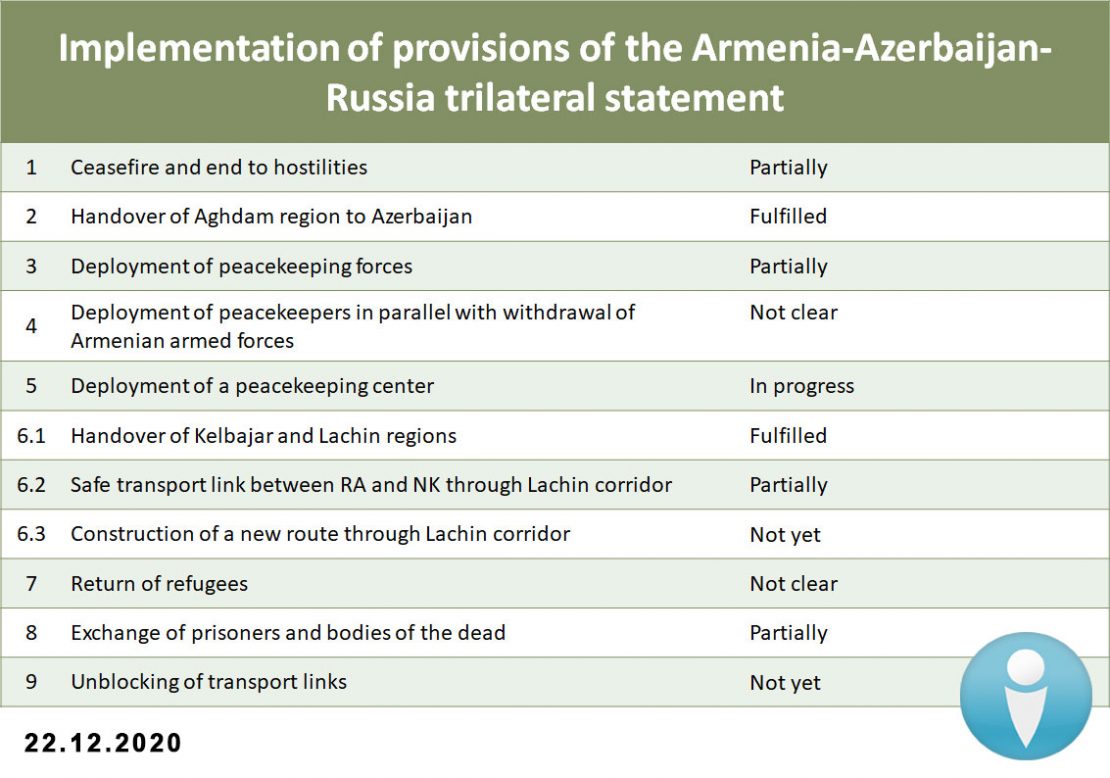- 22 December, 2020
- Foreign Policy

On November 9, 2020, a joint statement of the leaders of Armenia, Azerbaijan and Russia put an end to the hostilities unleashed by the Azerbaijani side on September 27.
About 40 days have passed since the statement was adopted, but some of its provisions have not been fully implemented yet, and uncertainty remains on some of the clauses.
The nine clauses
The nine clauses of the statement are as follows:
1․ A complete ceasefire shall be established and all hostilities shall be stopped in the Nagorno-Karabakh conflict zone as of 00:00 Moscow time on November 10, 2020. The Republic of Azerbaijan and the Republic of Armenia, hereinafter referred to as the Parties, shall remain at their current positions.
2․ Aghdam region shall be returned to the Republic of Azerbaijan until November 20, 2020.
3․ Peacekeeping troops of the Russian Federation shall be deployed along the line of contact in Nagorno-Karabakh and along the Lachin corridor, including 1,960 servicemen with firearms, 90 armored personnel carriers, 380 units of motor vehicles and special equipment.
4. The peacekeeping troops of the Russian Federation shall be deployed in parallel with the withdrawal of the Armenian armed forces. The peacekeeping troops of the Russian Federation shall stay there for a period of 5 years, with automatic extension for the next 5-year periods, if none of the Parties declares of its intention to terminate the application of this provision 6 months before the expiration of the preceding period.
5․ A peacekeeping center shall be deployed to monitor the ceasefire with a view to increasing the effectiveness of control over the implementation of the agreements reached by the Parties to the conflict.
6․ The Republic of Armenia shall return the Kelbajar region to the Republic of Azerbaijan by November 15, 2020, and the Lachin region by December 1, 2020. The Lachin corridor (5 km wide), which will provide for communication between Nagorno-Karabakh and Armenia and at the same time will not affect the city of Shushi, shall remain under the control of the peacekeeping troops of the Russian Federation. A plan for the construction of a new route along the Lachin corridor shall be determined within the next three years, providing communication between Nagorno-Karabakh and Armenia, with the subsequent redeployment of Russian peacekeeping troops to protect this route. The Republic of Azerbaijan shall guarantee traffic safety for citizens, vehicles and goods in both directions along the Lachin corridor.
7․ Internally displaced persons and refugees shall return to Nagorno-Karabakh and adjacent areas under the control of the Office of the UN High Commissioner for Refugees.
8․ An exchange of prisoners of war, hostages and other detained persons and bodies of the dead shall be be carried out.
9․ All economic and transport links in the region shall be unblocked. The Republic of Armenia shall guarantee the safety of transport links between the western regions of the Republic of Azerbaijan and the Nakhichevan Autonomous Republic with a view to organizing the unimpeded movement of citizens, vehicles and goods in both directions. Control over transport communication shall be exercised by the Border Guard Service bodies of the FSS of Russia. The Parties agree that the construction of new transport communications linking the Nakhichevan Autonomous Republic with the western regions of Azerbaijan shall be provided.
The 40 days
As it has already been mentioned, more than 40 days have passed since the signing of the statement. It goes without saying that some of the provisions of the statement, such as the construction of new roads, could not have been implemented during this period. Nevertheless, 40 days seems a reasonable time for implementation of other provisions, some of which have been implemented either partially or not at all.
Thus, as for the territories to be handed over to Azerbaijan, the provisions of the statement have been fulfilled in full. Aghdam, Kelbajar and Lachin regions were handed over to Azerbaijan (based on mutual agreement, the Kelbajar region was handed over on November 25 instead of November 15) in compliance with relevant provisions of the statement.
However, according to the first clause of the same statement, the forces of the conflicting parties shall have remained at their current positions. As of 00:00 Moscow time on November 10, Armenian forces were stationed in the villages of Khtsaberd and Hin Tagher in the Hadrut region, as well as on Mount Dizapayt. That is, those territories should have remained under the control of the Artsakh Republic. However, the situation around these last villages in the Hadrut region, which remained under Armenian control, remains uncertain. On December 13, the Azerbaijani special forces positioned themselves near the Hin Tagher and Khtsaberd, and after several hours of fighting, they managed to enter the village of Hin Tagher. At least 9 servicemen of the Armenian army died during the battles, and several dozen soldiers have been captured. The fate of those villages is still uncertain. Interestingly, these areas were not on the Russian peacekeeper deployment map published by the Ministry of Defense of the Russian Federation, but then they appeared and were subsequently removed from the map again.
By the way, as regards the deployment of Russian peacekeepers, according to the provisions of the statement, the Russian peacekeepers were to be deployed “along the line of contact in Nagorno Karabakh, and along the Lachin corridor.” However, Russian peacekeepers have not been deployed along the line of contact between Karabakh and Azerbaijan, and, in fact, the control of the line of contact continues to be exercised by the Artsakh Defense Army. In this context, the 4th clause of the statement, according to which the Russian peacekeepers shall be deployed “in parallel with the withdrawal of the Armenian armed forces” is noteworthy. This clause contains a number of uncertainties, as it does not specify where the peacekeepers should be deployed “in parallel with the withdrawal of the Armenian Armed Forces.” And then the question of where these forces should withdraw from, whether from along the line of contact or from the three regions handed over to Azerbaijan (which has already been done), is not clear.
The issue of the Lachin corridor is also a subject of discussion. Contrary to the provisions of the statement, Azerbaijan has not ensured “traffic safety for citizens, vehicles and trucks in both directions along the Lachin corridor”. In particular, just one day after the signing of the declaration, the founder and president of the “New Armenia Homeland-Diaspora” charitable NGO, Gevorg Sujyan, and his friends were captured on the Berdzor-Shushi road (along the Lachin corridor). The corridor is currently controlled by Russian peacekeepers.
One of the most painful circumstances was the fact that a large number of Armenian servicemen were in captivity in Azerbaijan. According to the statement, the parties were to exchange prisoners of war, hostages, other detainees and the bodies of the dead.
However, according to the Armenian side, Azerbaijan creates artificial obstacles to the full implementation of this process. Despite the fact that the Armenian side and the Azerbaijani side have stated that they agree to the exchange of prisoners on the principle of “all for all”, many Armenians remain in captivity in Azerbaijan. A large group of hostages, 44 people, returned to Armenia from Azerbaijan only on December 14, and the dates of return of other hostages had not been announced at the time of writing this article.
The details of the establishment of a Russian-Turkish peacekeeping center, which, according to some information, will be located in the Azerbaijani city of Barda, are still unclear.
There is also an uncertainty around the seventh clause of the statement, according to which “internally displaced persons and refugees shall return to Nagorno-Karabakh and adjacent areas under the control of the Office of the UN High Commissioner for Refugees “.
This clause raises at least two questions. Is it about the return of Azeri refugees to the Armenian-controlled territories of Artsakh, or is it about the return of Armenian refugees to the Azerbaijani-occupied settlements in Artsakh, such as Shushi and Hadrut?
The 9th clause of the statement, according to which “all economic and transport links in the region shall be unblocked” remains outstanding. Does this mean that a territory can be opened from Armenia to Russia via Azerbaijan, or does it only mean that Armenia will be obliged to provide roads to Azerbaijan to establish contact with Nakhichevan? However, it should be noted that the Armenian and Azerbaijani sides are still locating interstate borders, which is accompanied by some tension, and statements on unblocking economic and transport links have not been made, at least by the Azerbaijani side.
Thus, to summarize the implementation processes of the last 40 days, we can state that the aforementioned uncertainties, lack of deadlines for important issues for Armenia, violations by Azerbaijan and lack of adequate responses to them destabilize the already fragile and explosive situation.
Vahe Ghukasyan
Union of Informed Citizens





